
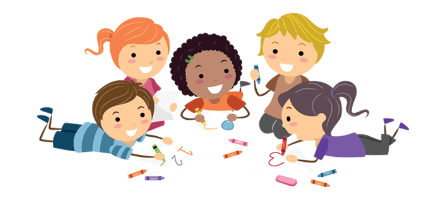
These Learning Activity Calendars are for all students unable to engage in remote learning. All activities are child-centered, developmentally appropriate learning experiences. Organized through the Four Frames of the Kindergarten Program, these learning opportunities provide parents with activities relevant to the integrated way in which learning occurs for our youngest learners. It is our hope that these learning experiences for home will support the continued development of the students in Kindergarten classes.
If you’d like to download the whole packages as a PDF, click the corresponding dates: April 21st – 23rd | April 26th – 30th | May 3rd – 7th | May 10th – 14th | May 17th – 21st | May 25th – 28th | May 31st – June 4th | June 7th – 11th | June 14th-18th | June 21st – 25th | January 3rd – 7th
- April 21-23
- April 26-30
- May 3-7
- May 10-14
- May 17-21
- May 25-28
- May 31-June 4
- June 7-11
- June 14-18
- June 21-25
- Coming Soon
Tuesday
Optional Read Aloud: Duck! Rabbit! By: Amy Krouse Rosenthal
| 4 Frames | Learning Opportunities |
| Belonging and Contributing | Caring for our Environment Challenge. Today’s challenge is to get outside with a grownup and help to keep your neighborhood clean. If you see garbage on the ground, toss it in a garbage can. |
| Demonstrating Literacy and Mathematics Behaviour | Rhyme Detective While going for a walk outdoors (or walk around your home) look for and name ten objects. Make up a rhyming word for each object you found. These words can be real or nonsense words (e.g., chair-bear; floor-more; window-bindow, tree-me)! Take turns with someone and see how many rhymes you can come up with together. Extension: Bring something to write on and a pencil on your walk. Write down the objects you found. Try and put these words into sentences. Choose one of the objects you found and draw a picture of all the things you can think of that rhymes with that word.Does it Sink or Float? With a grown up, fill up a bucket or large bowl with water. Find 10 objects from around your home, inside or outside. Before you put the object in the water make a hypothesis (your best guess) if the object will sink or float. Drop the objects one at a time into the water to see what happens. Were you correct with your hypothesis? How do you know this? Extension: On a piece of paper create a chart to document your findings. At the top of the page print the words “sink “and “float”. List the objects under the correct word. |
| Problem Solving and Innovating | Treasure Map Pick an item in your home and hide it! Then using a pencil or marker create a treasure map on a piece of paper. Include instructions (text and/or pictures) as clues to finding the lost item! Ask a person in your home to follow your map to find the lost item. Suggestions for the instructions could be:
Reflection: Were the instructions helpful to find your lost item? Did you have any problems? Would you do anything differently? How might you make it more challenging? |
| Self-Regulation and Well-Being | The Guessing Game Look for 5-10 different objects around your home (inside or outside). One at a time put them into a bag, basket, box, or backpack. Guess what is in the bag by asking questions; Is the object hard or soft? big or small? What shape is it? Can you eat it? Can you smell it? Are you able to figure out what it is?Extension: Change roles! Have the child look for the objects and place them in the bag, basket, box, or backpack. Now switch roles and ask the questions and guess. |
Wednesday
Optional Read Aloud: Old MacDonald Had Her Farm By: JonArno Lawson
| 4 Frames | Learning Opportunities |
| Belonging and Contributing | Caring for our Environment Challenge. Today’s challenge is to help save energy. Don’t forget to turn off the lights when you leave the room. |
| Demonstrating Literacy and Mathematics Behaviour |
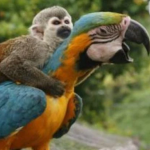 A Monkey and a parrot Using the picture provided, share a story about what is happening in this picture with someone in your home. Use the following questions to add supporting details to your story: What do you see? What happened before this picture was taken? What do you think will happen next? Writing extension: On a piece of paper, label and/or write a sentence to represent your story. Measurement |
| Problem Solving and Innovating | Target Practice Use any type of ball you have in your home (e.g., tennis ball, basketball, soccer ball) or make “balls” from paper/newspaper by scrunching the paper into a ball shape. Set up a basket (e.g., laundry basket, box, large bowl) on the other side of the room or in an outdoor space. Begin to throw the balls into the basket. Count how many are in the basket and how many are not in the basket. Explain if you had more or less in the basket. Challenge yourself by moving the basket farther away. |
| Self-Regulation and Well-Being | Spy Detective: Can you be a detective? Collect 5-10 items that are familiar to you (e.g., a pencil, a small ball, a piece of Lego, a small toy, a spoon). With someone in your home play spy detective. Put 5 of the items you collected on a table or on the floor. Have the child look at the items for 10 to 15 seconds. Once the child has looked at them for 10 to 15 seconds, cover the items with a small blanket, a tablecloth, a pillowcase, or a tea towel. Ask them to tell you what is hidden under the blanket and see if they remember. Start with 5 items and increase the number of items to challenge your memory. |
Thursday
Optional Read Aloud: Chicken, Pig, Cow by Ruth Ohi
| 4 Frames | Learning Opportunities |
| Belonging and Contributing | Caring for our Environment Challenge. Today’s challenge is help save water. Don’t forget to turn off the water while you are brushing your teeth. |
| Demonstrating Literacy and Mathematics Behaviour | Thumbs Up/Thumbs Down for Beginning Sounds This is a partner game that can be played with someone in your home. The grownup will read the list of words and the student will have to determine if the initial sound is the same. If it is, then it’s a thumbs up. If the initial sounds are not the same, then thumbs down.Word Pairings:Map/Nap (down) Play/Plane (up) Climb/Clap (up) Book/Read (down) Light/Sound (down) Brown/Down (down) Bed/Bike (up) Stick/Stamp (up)Nature NumbersDuring your time outside or from a window in your home, count how many of something you can see. For example: I see 3 birds; I see 4 tires; I see four doors, I see 2 trees.Extension: Draw a picture of what you saw on your walk. Write the number of items beside your picture. |
| Problem Solving and Innovating | Build a Home for your favourite toy, animal, or character. Gather empty grocery boxes (cereal, crackers etc.), shoe boxes, or small baskets. Can you make a home? If available, use masking tape or glue to help with building. Have a discussion about how many boxes you are using, the number of sides and corners on the boxes. Think about other items that could be used to add to your home. Before you start, develop a plan. How will you build your home? What steps will you take? Draw a picture to represent your plan. After you have built your home, discuss where the toy, animal, or character is in relation to the home (e.g., in front of, behind, inside, on top of, beside). |
| Self-Regulation and Well-Being | Listening Walk Take a walk in your neighbourhood. Find a spot to stop for a few minutes and listen together for sounds in nature. Talk about what you hear, smell, see and feel outdoors. Encourage deep breathing by breathing in to the count of 5, exhale to the count of 5. Repeat. |
Friday
Optional Reading Aloud: Anything is Possible By: Guilia Belloni
| 4 Frames | Learning Opportunities |
| Belonging and Contributing | Caring for our Environment Challenge. Today’s challenge is to recycle cans, bottles, and paper. Help your family recycle by putting these items in a recycling bin so they are ready for the next garbage day pick up. |
| Demonstrating Literacy and Mathematics Behaviour | Concentration Game Preparation: From the following Kindergarten word list, write 10 high frequency words on cards: no, is, can, me, you, and he, at, a, so, on, in, up, am, we, like, see, I, go, it, do, an, the, my, to. You will need two sets of words which creates a set of 20 cards.Play! Place cards face down on a table (start with a small number of words and increase slowly). Each player turns over two words and reads them. If a match is made the player keeps the cards and gets another turn. Play until all the cards have been collected.  Fabulous Ten Fabulous Ten Extension: Can you write or draw a list of the objects you found? On your list, tally how many of each object you found. Then, count your tally and write the number (e.g., 10). |
| Problem Solving and Innovating | Building Ramps Ramps help children gain experience with force and motion. With the help of a grownup, locate planks of wood, or long pieces of cardboard (e.g., cereal boxes, broken down cardboard boxes). This will be your ramp. Then, build a platform (e.g., pillows, smaller boxes, chair or couch) to hold up your ramp. Use balls, toy cars, or things that roll or move from around your home to understand how your ramp works. Try moving your ramp higher or lower. What happened?Extension: Explore differences in speed and distance. Make a guess about which objects will move faster, slower, or farther. Write down your findings. Were your guesses correct? How do you know this? What could you do differently to get a different result? |
| Self-Regulation and Well-Being | Breakfast, Lunch or Dinner Collect old magazines, flyers, printed or drawn pictures of healthy foods. Draw three plates on a piece of paper. Explain that they will use the pictures to create three different meals for your family using foods from each food category (whole grain foods, protein foods, and fruits/vegetables). The child will cut out their chosen healthy food items and glue, tape or place them onto the plates. When complete, review the meals they made and ask the child to describe their meals and discuss why it is important to eat foods from each food category.Extension: You can make one of the meals if the ingredients are available. From the three you made, which meal is your favourite? Why? |
Monday
Optional Read Aloud: Do Frogs Drink Hot Chocolate? By: Etta Kaner
| 4 Frames | Learning Opportunities |
| Belonging and Contributing |
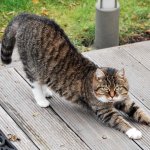 Cat Stretching Picture of the Day: Take a minute to look at the photo. With someone in your home discuss: What is happening in the photo? What makes you say that? |
| Demonstrating Literacy and Mathematics Behaviour | Spring Words After taking a walk with a grownup, or when looking out a window in your home, what are some words you can think of to describe spring in Canada? (e.g., warm, wet, windy, cloudy, sunny). What are some activities we can do in the spring? (e.g., walk, ride a bike, play at the park, fly a kite)Extension: Can you write the letters that these spring words start with? Can you try to write part of the word or the whole word?Name Numbers Write your name with the help of a grownup or write your name yourself. How many letters are in your name? Are there more than 10 letters? Less than ten letters? What about your second name or last name? Are there more than 10 letters? Less than ten letters? Does your first name have more letters than your second name?Extension: Can you count to 10? Can you write these numbers? Can you trace these numbers? Can you count to 20? Can you write these numbers? |
| Problem Solving and Innovating | Feel like Dancing? *Note: only select shapes and movements you feel most comfortable with and have room to try. Dancers often use different parts of their body to tell a story. They connect the speed and beat of the music to the shape they make. A twisted, tight, curled up shape might be used to show someone is sad. A big, open star shape might be used to show someone is happy. Try out these shapes.
What can you get different parts of your body to do? Can you move quickly, slowly or even in a pattern like: slowly, quickly, slowly, quickly? Extension: Now that you have tried making shapes with different parts of your body and moving at different speeds, can you choose your 3 favourite moves and connect them together? Try them with music. |
| Self-Regulation and Well-Being | Mind Bubbles
Extension: |
Tuesday
Optional Read Aloud: Nathan Saves Summer By: Gerry Renert
| 4 Frames | Learning Opportunities |
| Belonging and Contributing |
 Jumping in Puddles Take a minute to look at the photo. With someone in your home discuss: What is happening in the photo? What makes you say that? |
| Demonstrating Literacy and Mathematics Behaviour | Musical Letters Find a few pieces of paper and something to print with. Using scissors, cut (or tear) the paper into pieces. On each of the pieces print one letter or have a grown up write the letters you tell them to. Use a mix of letters, but there is no need to use all twenty-six. In a room with a lot of space, scatter the letters. Next, you will need music (play on the tv, radio, or sing). Take turns with someone playing this game. Play the music and move and groove. Pause the music and CALL out a letter. Find the letter that is called and stand on it.Extension: What is a word you can think of that starts with this letter? 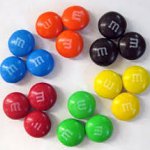 Candy Math What Math Do You See? When you look at the image of different coloured candy pieces what do you notice? Child might discuss what they know about patterns, shapes, numbers, colours. |
| Problem Solving and Innovating | I am an Innovator An innovator is like an inventor. Talk to someone in your home about something you would want to invent to help you or someone else. Maybe you could invent a different way to get to school? Can you be an innovator? Before you start you will need a plan. Start off by printing, “My innovation ideas” at the top of a piece of paper. Then, draw a picture of what you would invent. Can you label your picture? Share your work with someone in your home. |
| Self-Regulation and Well-Being | The Five Senses Seeing, hearing, smelling, tasting, touching, and feeling are the five senses. We use these five senses to learn about the world and what is happening around us. Take a walk around your home (inside and/or outside).
|
Wednesday
Optional Read Aloud: Little Boy By: Alison McGhee
| 4 Frames | Learning Opportunities |
| Belonging and Contributing |
 Blowing Tree Picture of the Day: Take a minute to look at the photo. With someone in your home discuss: What is happening in the photo? What makes you say that? |
| Demonstrating Literacy and Mathematics Behaviour | Story Predictions Look at the picture (see image). Make a prediction about what you think the book is about. How do you know that? What do you think happens next? How do you think the story ends?
Extension: Can you tell someone in your home what you think the story is about? You could also tell the story by drawing, and/or adding letters and words. Scavenger Hunt
Extension: Use a measuring tool (e.g., a ruler, measuring tape, string, spoon, hands/feet) to find out the length of the items you found. Write down how long the item is. |
| Problem Solving and Innovating | Block Play There are many items around the house that can be used as “blocks”. Examples you might find around the home could be boxes (e.g., shoebox, Kleenex, cereal, packing), empty pringles can, empty paint tins, sponges, plastic cups. Adding play materials like vehicles, stuffed animals, small toys, natural items (e.g., pebbles, pinecones, acorns) can enhance block play. Can you make a plan? Write or draw that plan on a piece of paper or tell someone in your home. Explore the items you collected. |
| Self-Regulation and Well-Being | Guess Who This game involves guessing what the other person is pretending to be. Ask the child to choose an animal (but not say what they chose). Ask the child to think about the way the animal moves. Encourage the child to move like the animal they have chosen. Try and guess what the animal is. Take turns to move like different animals. Ask each other questions to help you guess. Try playing the game using different people you know, fruits and vegetables, places, rooms in the home. |
Thursday
Optional Read Aloud: Golden Threads By: Suzanne Del Rizzo
| 4 Frames | Learning Opportunities |
| Belonging and Contributing |
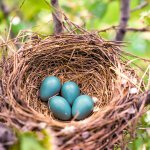 Robin’s Nest with Eggs Picture of the Day: Take a minute to look at the photo. With someone in your home discuss: What is happening in the photo? What makes you say that? |
| Demonstrating Literacy and Mathematics Behaviour | Letter Hunt Print all the letters of the alphabet or have a grownup help you to do this. You could then use this list as a checklist. Find a text in your home. The text could be a book, magazine, newspaper, mail, recyclable etc. Search for each letter of the alphabet until you have found them all. Cross off the letter on your checklist you find them to help you know what letter you need to look for.Extension: Practice printing the letters of the alphabet and some of the letters you find. Or search for high frequency words in the text (e.g., like, in, to, no, am, that, can, me, yes, you, etc.)  A lot of peppers Counting Peppers! |
| Problem Solving and Innovating | Hide and Seek Do you know what camouflaged means? It is the way a plant or animal uses its colour, shape and/or texture to blend in with its surroundings to prevent it from being seen. Play a game of hide and seek by hiding a toy animal (or something else) in an accessible place around your home. Hide the toy in plain sight (e.g., not in cupboards, closets, under furniture, etc.), but also where it blends in with the surroundings, where it is camouflaged. Ask someone in your home to look for the “hidden” toy. Was it easy to find? Why or why not? Hide the toy in different locations, places where the camouflage varies. Is it easier or harder to find? Why or why not? |
| Self-Regulation and Well-Being | Swaying Trees Sit tall or stand with your feet apart. Balance evenly on both feet if standing. Keep your eyes open. Imagine you are a tree in the wind, and your arms are the branches. Swing your arms side to side like swaying branches. Bend forward at the waist and keep swaying your arms. Come up slowly, continually swaying your arms side to side. Bend and sway until you feel as free as a tree moving in a light breeze. Finish by taking three soft, slow breaths. Does your body feel different than it did before the exercise? |
Friday
Optional Reading Aloud: Dojo Daycare By: Chris Tougas
| 4 Frames | Learning Opportunities |
| Belonging and Contributing |
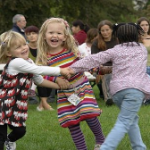 Having Fun Picture of the Day: Take a minute to look at the photo. With someone in your home discuss: What is happening in the photo? What makes you say that? |
| Demonstrating Literacy and Mathematics Behaviour | Letter Match You will need paper (or even recyclables like a cereal box or cracker box) to create game cards. Create 52 small cards by cutting with scissors or tearing. On each piece, print one letter of the alphabet in lower case (e.g., a, b, c, d, e and so on). On the other 26 pieces, print one letter of the alphabet in upper case (e.g., A, B, C, D, E and so on). With the 52 game pieces, play a matching game and match the upper-case letters with the lower-case letters (e.g., Aa, Bb, Cc, Dd, Ed and so on).Extension: Play a memory game! Lay out all the game pieces face down (lowercase and uppercase) so you don’t know where the letters are hiding. Taking turns, flip two game pieces over and see if they match. If they do, you keep them. If they don’t flip them back and try again. The goal is to match all the letters. 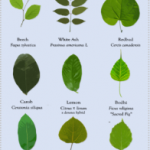 Leaves Which One is Different? |
| Problem Solving and Innovating | I Wonder! What questions do you have about the world? While outside with a grownup or while looking out a window inside your home, talk about what questions you have about the world? Why is the sky blue? What are clouds made of? What do you think the answers to these questions are? How could you find out? Draw a picture about your questions. |
| Self-Regulation and Well-Being |
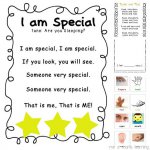 Special Poem I Am Special! |
Monday
Optional Read Aloud: Jabari Jumps by Gaia Cornwall
| 4 Frames | Learning Opportunities |
| Belonging and Contributing | Question of the Day can build confidence, promote conversation, and nurture communication skills. Possible times to ask the question of the day could be in the morning, before breakfast, or every night during dinner.
Would you live in a castle by yourself? |
| Demonstrating Literacy and Mathematics Behaviour |
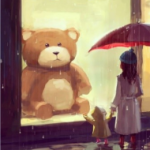 Teddy Bear Let’s Talk About It! Using the picture provided, share a story about what is happening in this picture with someone in your home. Use the following questions to add supporting details to your story: What/Who do you see? What happened before this picture was taken? What do you think will happen next? Writing extension: On a piece of paper, label and/or write a sentence to represent your story. Counting Trees |
| Problem Solving and Innovating | Rolling Dice Before you start the game, you will need one dice. If you don’t have dice, you could write numbers on a piece of paper (1,2, 3…6) to represent the same numbers on a dice. You will then need to write down a few categories of things (e.g., colours, animals, places, people etc.) on card-sized pieces of paper. Now, for the fun part! Put the cards face down between you and your game partner. Choose a card and roll the dice. Think of the number of things that fit into the category on the card. For example, if you chose a card that has “animals” and rolled a three, you might say, “hippo, dog, rooster”. Take turns. |
| Self-Regulation and Well-Being | Obstacle Course Create an obstacle course with someone in your home. This is a great way to explore materials, express creativity and move your body. You will need a variety of materials to build your obstacle course. Take a look around your home and what is safe to use. Examples might be putting tape on the floor as a balance beam, crawling under a table, climbing over a chair, using pillows as stepping stones. |
Tuesday
Optional Read Aloud: Be You by Peter H. Reynolds
| 4 Frames | Learning Opportunities | ||||
| Belonging and Contributing | Question of the Day can build confidence, promote conversation, and nurture communication skills. Possible times to ask the question of the day could be in the morning, before breakfast, or every night during dinner.
Would you wear a hotdog costume? |
||||
| Demonstrating Literacy and Mathematics Behaviour | Thumbs Up/Thumbs Down for Beginning Sounds This is a partner game that can be played with someone in your home. The grownup will read the list of words and the student will have to determine if the initial sound is the same. If it is, then it’s a thumbs up. If the initial sounds are not the same, then thumbs down.
Coin Flipping |
||||
| Problem Solving and Innovating | Sequence Cards Create a sequence game with a grown up. For this, you can write sentences or draw pictures (or both!). Think of a task like making a sandwich, brushing your teeth, making your bed or walking the dog. What are the steps you would take to complete the task? Write or draw each step of the task you chose on different pieces of paper. Once finished, mix up the steps and try and put them in order. |
||||
| Self-Regulation and Well-Being | Make Music During outside time with a grownup, look for natural objects that could be used to make music. Try hitting the objects together, blow through them, strum them to make musical using natural musical instruments.Examples of what to look for:
|
||||
Wednesday
Optional Read Aloud: Old MacDonald Had a Truck by Steve Goetz
| 4 Frames | Learning Opportunities |
| Belonging and Contributing | Question of the Day can build confidence, promote conversation, and nurture communication skills. Possible times to ask the question of the day could be in the morning, before breakfast, or every night during dinner.
Would you invite a clown to dinner? |
| Demonstrating Literacy and Mathematics Behaviour | Rhyme Time! Collect 10 objects from around the house (e.g., stuffed animal, block, book, spoon, sock, etc.) and place them in a bag or pillowcase. Pull each item out one by one and come up with three rhyming words for each item (e.g., sock: clock, dock, knock). Silly rhyming words count too!Make a Survey! 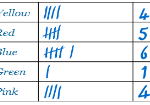 Make a Survey Choose a topic of interest – something that you like e.g., dinosaurs, cars, sports. Create a question that you want answered. For example, what is your favourite colour? When you are using a survey, you can use tally marks to show each person’s answers. See the photo. Ask people in your family and/or call other family members. An alternative could be, have them write down their favorite color on a piece of paper and drop it in a bowl. Then, put all the pieces of paper into piles and count them. |
| Problem Solving and Innovating | Play with Water! With a grownup, fill up a bucket or sink with water. Find items (e.g., a funnel, measuring cups/spoons, sponges, small plastic toys, wash cloth, dish soap to make bubbles) that you could add to your water. Don’t forget a towel for cleanup! Roll up your sleeves and explore how the water feels. During play you might ask “how does the water sound when you pour it?”, “do your measuring cups hold the same amount of water?”, “what did you find out when you put ___ in the water?”. |
| Self-Regulation and Well-Being | Nature Sensory Bin Sensory bins can be done inside or outside and helps to support self-regulation while exploring different textures and shapes. To create a sensory bin, you will need a large container (e.g., box, basket, plastic container). Then, you will need to gather a variety of items from your backyard, the park, or on a walk. Look for natural items that are different in size, shape and texture like pinecones, leaves, dandelions, acorns or pebbles. Add sand or water if you enjoy running your hands through it. |
Thursday
Optional Read Aloud: Pete the Cat: Checks out the Library by James Dean
| 4 Frames | Learning Opportunities |
| Belonging and Contributing | Question of the Day can build confidence, promote conversation, and nurture communication skills. Possible times to ask the question of the day could be in the morning, before breakfast, or every night during dinner.
If a troll lived under a bridge, would you cross it? |
| Demonstrating Literacy and Mathematics Behaviour | I am Happy! Draw a picture of your face when you are happy. Underneath your drawing, write a list of five things that make you happy! Materials you could use include:
Extension: Write them in sentences (e.g., ‘I like running’, ‘skipping makes me happy’, etc.). Share what makes you happy with someone in your home. Search and Find! |
| Problem Solving and Innovating | Exploring a Flower During a walk outside with a grownup, try and find a flower. Look at the different parts of the flower. What do you notice? What colours, shapes, and textures do you see and touch? Can you draw the flower you saw? Create a diagram of the flower and label the different parts of the flower (e.g., petals, stem, leaves). |
| Self-Regulation and Well-Being | Let’s Pretend! Either indoors or outdoors, pretend to be different animals. Try to imitate the movements of different animals to practice coordination and balance. Hop on all fours like a frog and say “ribbit-ribbit-ribbit” or bend your knees, walk with your legs far apart, and swing your arms like a chimpanzee, stretch like a giraffe or jump like a kangaroo. |
Friday
Optional Reading Aloud: Sky Color by Peter H. Reynolds
| 4 Frames | Learning Opportunities |
| Belonging and Contributing | Question of the Day can build confidence, promote conversation, and nurture communication skills. Possible times to ask the question of the day could be in the morning, before breakfast, or every night during dinner.
If you found a pot of gold, would you share it? |
| Demonstrating Literacy and Mathematics Behaviour | Reading Engagement with a Bookmark! Let’s make a bookmark! Here are some possible items to use for your bookmark:
Cut out a long rectangle from the piece of paper/cardboard (Have a grownup help). Decorate with anything you’d like and don’t forget to write your name! Now with your new bookmark, find your favourite thing to read! Snuggle up and enjoy reading and place your bookmark in your book when you are ready for a break. Enjoy! Nature Object Count. |
| Problem Solving and Innovating | Ramp It Up! Ramps help gain experience with force and motion. With the help of a grownup, locate planks of wood, or long pieces of cardboard (e.g., cereal boxes, broken down cardboard boxes). This will be your ramp. Then, build a platform (e.g., pillows, smaller boxes, chair or couch) to hold up your ramp. Use balls, toy cars, or things that roll or move from around your home to understand how your ramp works. Try moving your ramp higher or lower. What happened?Extension: Explore differences in speed and distance. Make a guess about which objects will move faster, slower, or farther. Write down your findings. Were your guesses correct? How do you know this? What could you do differently to get a different result? |
| Self-Regulation and Well-Being | Let’s practice how to calm our body. Take a deep breath in and like you’re smelling a beautiful flower. Breathe out like you’re blowing out candles on a cake. Does your belly fill up with air? Do you feel your body calming? Repeat breathing until you feel calm. |
Monday
Optional Read Aloud: The Proudest Blue by Ibtihaj Muhammad and S.K. Ali
| 4 Frames | Learning Opportunities |
| Belonging and Contributing | Stewardship means a sense of connection to, caring about, and responsibility for each other and the natural world around us.
Can you be a stewardship of the environment? What better way to foster a love of the environment than spending time outside and exploring nature? With a grownup, go for a hike or even a quick nature walk or spend time in a local green space. |
| Demonstrating Literacy and Mathematics Behaviour | Let’s Talk About It!
Sorting Laundry! Can you help a grown up with laundry! Can you sort the laundry items into different piles? You could ask “I wonder how we might sort the laundry?”. Follow the child’s lead and then ask, “how did you sort them?” (e.g., by size, colour, style). Extension: what patterns do you notice? Can you find a big sock and a little sock? How many white/black socks can you find? Create a graph with the different laundry items and include how many of each item you have. |
| Problem Solving and Innovating | Loose parts play is a great way for children to use their imagination, work on fine motor skills, and explore different materials. Examples of loose parts might be plastic cups and lids, egg cartons, stones, boxes, straws, pinecones and acorns, bubble wrap, paper tubes. Begin by gathering different items around your home (inside or outside) and then spend time exploring those items. A grownup might ask questions or make observations during the play (e.g., talk about shapes, colours, textures you notice, “tell me about how you designed that”, “what do you think you could do with these pinecones and acorns?”). |
| Self-Regulation and Well-Being | Play red light, green light!
With a grown up, find a safe open space (e.g., a park, a sidewalk, a driveway). Stand on one side of the space. Listen to the instructions. The grown up will call out either green light or red light. For green light you will move your body towards the grown up. For red light, you will stand still. Continue until you catch up to the grown up. Take turns being the caller. |
Tuesday
Optional Read Aloud: All Are Welcome by Alexandra Penfold
| 4 Frames | Learning Opportunities |
| Belonging and Contributing | Stewardship means a sense of connection to, caring about, and responsibility for each other and the natural world around us.
Can you be a stewardship of the environment? Start a conversation with someone in your home about saving water! Do you turn the water off when you’re brushing your teeth? Do you know that taking a shorter shower every day could save gallons of water over time? Did you know that showers use less water than taking a bath? |
| Demonstrating Literacy and Mathematics Behaviour | Name Scavenger Hunt! Using the letters in your name, find objects around your house that represent the sound of each letter. Write down the objects/tell a grownup the objects you have found! For Example: My name is Jacob. J – jar A – apple C – couch O – orange (shirt) B – book Extension: Challenge yourself to find 3 items for every letter of your name or try your last name!Exploring ShapesGo for a hunt around your home or outside during a walk and find shapes! Discuss how you know what the shape is. How many circles did you find? How many squares? Any triangles? Extension: Look for other items around your home to practice drawing shapes (e.g., square, rectangle). Can you name the shapes? Label the shapes? Write down the number of shapes (e.g., I can draw 4 squares)? Can you build with all the items you collected? Tell someone about what you created! |
| Problem Solving and Innovating | Treasure Map
Pick an item in your home and hide it! Then using a pencil or marker create a treasure map on a piece of paper. Include instructions (text and/or pictures) as clues to finding the lost item! Ask a person in your home to follow your map to find the lost item. Suggestions for the instructions could be:
Reflection: Were the instructions helpful to find your lost item? Did you have any problems? Would you do anything differently? How might you make it more challenging? |
| Self-Regulation and Well-Being | Listening Walk
Take a walk in your neighbourhood. Find a spot to stop for a few minutes and listen together for sounds in nature. Talk about what you hear, smell, see and feel outdoors. Encourage deep breathing by breathing in to the count of 5, exhale to the count of 5. Repeat. |
Wednesday
Optional Read Aloud: A Squiggly Story by Andrew Larson
| 4 Frames | Learning Opportunities | ||||||||
| Belonging and Contributing | Stewardship means a sense of connection to, caring about, and responsibility for each other and the natural world around us.
Can you be a stewardship of the environment?
|
||||||||
| Demonstrating Literacy and Mathematics Behaviour | Lions, Tigers and Bears, Oh My! Using the list of ten animal names, clap the syllables for each animal. Sort them into categories based on the number of syllables they have.
List of animals: Loose Parts Play! Collect loose parts at home (e.g., coins, paper clips, bottle caps, bread tags, etc.) or outside (e.g., pinecones, pebbles, dandelions) to create different patterns. Using the items you have collected, try to create a pattern. Think about how the pattern repeats itself. How many times will you make the pattern repeat? What are the ways you can make a pattern so that it doesn’t always go in a straight line? |
||||||||
| Problem Solving and Innovating | Building, Building, Building!
Can you build a home for one of your stuffed animals or toys? What materials will you need to build your home? (e.g., food containers, paper tubes, blocks and boxes). Make a list of items. Then, create a plan either by telling a grownup your plan or drawing how you will build your home with the materials you collected. Build your home! Extension: After building the home you might ask: Tell me about your home. What would you do different next time? How could you make your home bigger/smaller/taller/wider? |
||||||||
| Self-Regulation and Well-Being | I Am Unique!
Look in the mirror. Discuss what you see and the things that make you unique and special. Create movements based on different feelings. Show someone in your home how to move their body if they were sad, happy, upset, angry, excited, scared, nervous, sick, tired. |
Thursday
Optional Read Aloud: Rocket Writes a Story by Tad Hills
| 4 Frames | Learning Opportunities |
| Belonging and Contributing | Stewardship means a sense of connection to, caring about, and responsibility for each other and the natural world around us.
Can you be a stewardship of the environment? While on a walk, look for 3 different kinds of flowers. What colour are they? How are they the same? How are they different? |
| Demonstrating Literacy and Mathematics Behaviour | Let’s Play Bang!
Customize your own word game. Here’s what you’ll need: an empty container, some blank pieces of paper cut into cards, and some markers. Write down the 15 words on little cards. How to Play Bang! 1. Players take turns reaching into the container and pulling out a card.If they can read the word aloud correctly, they get to keep the card. If the player is incorrect, the card goes back into the container. Terrific Ten |
| Problem Solving and Innovating | Gather some natural materials like sticks, rocks, dandelions, and pinecones from your yard, outside or from a trail. Can you create a picture of something with the materials you found? |
| Self-Regulation and Well-Being | Play “Head-Shoulders-Knees-Toes” to help your child learn and practice following instructions, thinking before they do an action, and staying calm/relaxed when things go wrong. Say “touch your head, shoulders, knees and toes”. Say the body part out loud when your child touches it. Do this again but in a different order (e.g., knees, head, shoulders, toes). Do this again but in a different order (e.g., toes, head, knees, shoulders). Next, say “listen to my words, touch your head” but touch your knees. Your child needs to touch the body part you said out loud “head” not knees! Try this again with a 3-5 more body parts. Extension: have the child lead the game. |
Friday
Optional Reading Aloud: A Color of his Own by Leo Lionni
| 4 Frames | Learning Opportunities | ||||||||||
| Belonging and Contributing | Stewardship means a sense of connection to, caring about, and responsibility for each other and the natural world around us.
Can you be a stewardship of the environment? During outdoor time, consider picking up 5 pieces of garbage (grownup approved). By picking up the garbage you are helping to keep our environment clean. Is the garbage you picked up for the trash or can it be recycled? How do you know? |
||||||||||
| Demonstrating Literacy and Mathematics Behaviour | If You Think You Know This Word
Sing this song to the tune of “If You’re Happy and You Know It”. Tell the child a segmented word sound by sound such as c-a-t. The child will blend the sounds together to discover the mystery word. Continue to practice three sound words from the suggested list:
Does it Sink or Float? With a grown up, fill up a bucket or large bowl with water. Find 10 objects that can be put into the water. Before you put the object in the water make a hypothesis (your best guess) if the object will sink or float. Drop the objects one at a time into the water to see what happens. Were you correct with your hypothesis? How do you know this? Extension: On a piece of paper create a chart to document your findings. At the top of the page print the words “sink “and “float”. List the objects under the correct word. |
||||||||||
| Problem Solving and Innovating | Laundry Art
|
||||||||||
| Self-Regulation and Well-Being | Let’s play freeze dance! In an open space (inside or outside), play music or sing a song. When the music stops you need to freeze (stop your body). Continue until the music ends or your body is tired! Extension: come up with different ways to pose when the music stops (e.g., yoga pose, imitate an animal, lift one foot off the ground). |
Monday
Optional Read Aloud: You and Me by Susan Verde
| 4 Frames | Learning Opportunities |
| Belonging and Contributing | Top Secret! Your mission is to be a detective and find out answers about the people who live in your home. Ask everyone the same question.
Do you have the letter A in your name? |
| Demonstrating Literacy and Mathematics Behaviour |
A picture is worth a thousand words! What kind of caption can you come up with for a funny family photo? Choose a couple of your favourite pictures! Can you find funny or silly pictures? Print the pictures out or draw a copy of each photo. Underneath each picture, write down a funny caption (ask a grown up for help with this if you need to). Then read out the photo captions to someone in your home and vote on the favourite ones! Let’s Measure! Find an item you can use to measure different objects around your home (e.g., a spoon, ruler, straw, stick). Can you find things that are smaller and bigger than your measuring tool? Make a list or draw pictures of the objects you measured. Circle the smaller objects. Extension: Count how many smaller things you found. Record the number. Then, count how many bigger things you found and record the number. Which number is bigger? |
| Problem Solving and Innovating | Your friend has lost their favourite toy. How will you help them to find it? How will you help them to feel better? Extension: An adult in your family asks for your help to bake a cake. What do you know about baking? How could you help them? Draw a picture to show your thinking. |
| Self-Regulation and Well-Being | Nature Time!
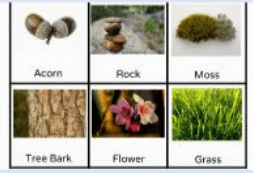 Nature Time Spend some time looking for nature. Use the photo as a checklist to help you remember what you are looking for. How many acorns did you find? How did the moss feel? Does it feel the same or different then the grass you found? Is your flower the same as the flower in the photo? How are they different? What does the tree bark feel like? |
Tuesday
Optional Read Aloud: Paper Bag Princess by Robert Munsch
| 4 Frames | Learning Opportunities | ||||||
| Belonging and Contributing | Top Secret! Your mission is to be a detective and find out answers about the people who live in your home. Ask everyone the same question.
Do you think bugs are creepy or cool? |
||||||
| Demonstrating Literacy and Mathematics Behaviour | Let’s Talk About It:
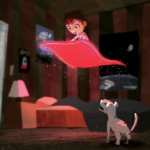 Flying Carpet Using the picture provided, share a story about what is happening in this picture with someone in your home. Use the following questions to add supporting details to your story: What/Who do you see? What happened before this picture was taken? What do you think will happen next? Writing extension: On a piece of paper, label and/or write a sentence to represent your story. Rock Walk! |
||||||
| Problem Solving and Innovating | Create a Puzzle! Find a box that is ready for the recycling bin (e.g., cereal, granola bar, cookie). First you will need to open both ends, bottom and top of the box. Along one of the skinny sides look for where the box is glued together. Slide your finger or the scissors down this section so that the box is now completely disassembled. Next, use scissors to cut up the rectangle sides of the box. You can use either the front or the back of the box to create your puzzle. On the plain cardboard side of the box draw different kinds of lines and then use your scissors to cut the box on the lines. An adult can help you if part is tricky. After you have finished cutting up the box – try and put the box back to together like a puzzle! Mix the pieces up and try again! |
||||||
| Self-Regulation and Well-Being | Roll, Read, and Move! Find a safe place where you can move your body. You will need a dice to play this game. If you don’t have one you could create 6 paper squares and draw the dots on the paper (e.g., 1 = one dot, 2 = 2 dots, 3 = 3 dots…up to 6). To play the game, roll the dice or choose a paper square, then choose a movement from the list under the matching number. Move your body! For active moves, do each move 5 times. For static moves, hold for 5 seconds. Take turns with someone in your home.
 Dice
|
Wednesday
Optional Read Aloud: Pete the Cat & the Missing Cupcakes by James Dean
| 4 Frames | Learning Opportunities |
| Belonging and Contributing | Top Secret! Your mission is to be a detective and find out answers about the people who live in your home. Ask everyone the same question.
Do you like hot or cold weather? |
| Demonstrating Literacy and Mathematics Behaviour | Word Recognition
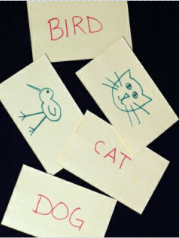 Word Recognition What You Need: Old magazines (optional) Glue (optional) How to Play: Representing Numbers! |
| Problem Solving and Innovating | Sock Ball Games Prepare your area for play. Choose an area where there is enough space to roll, catch, toss and maybe kick. Remove breakable items. Chairs, couches, laundry baskets and boxes can be used as goals or targets in games. Only play games you can safely play in your space. Make a sock ball. Roll and fold a pair of socks inside each other. For larger balls, use 3-4 pairs of socks. Adult socks work well. Get ready to play!Soccer
Bowling
Basketball
Throw and Catch
|
| Self-Regulation and Well-Being | Picnic Time Set up a picnic for your stuffed animals, toys and/or family members inside your home or in a nice space outside with a grownup. You might need a blanket or towel to sit on. Think about all the items you would need for your picnic. Maybe have your lunch or snack for your picnic. |
Thursday
Optional Read Aloud: This Is Me by Jamie Lee Curtis
| 4 Frames | Learning Opportunities |
| Belonging and Contributing | Top Secret! Your mission is to be a detective and find out answers about the people who live in your home. Ask everyone the same question.
Do you like rainbows? |
| Demonstrating Literacy and Mathematics Behaviour | Alphabet Hunt: Using a large piece of paper (or multiple pieces of paper), have the child use a marker/pencil to write all the letters of the alphabet in a column running down the left side of the piece of paper. Once they’ve written all the letters, it’s time for your child to find words that begin with the letter sound! Your child can explore their surrounding in their home, outdoors with a grownup or even find words in books or magazines! They might find a sock for S, banana for B, couch for C if they are searching around their home. As they find them, they should write, draw or tell a grownup the object next to its appropriate letter on the chart. The game continues until there’s something for each letter of the alphabet.Same and Different Find a tree in your backyard or close to your home (e.g., at a local park). What does the tree look like now? Do you think the tree will change? What season is coming next? What will the tree look like then? Draw a picture of the tree today and then plan a date on your calendar to go back to see it later. Make a prediction of what you think you will see when you visit your tree again. |
| Problem Solving and Innovating | Using a basket, box, or a bag collect a variety of items in your home that are of interest to you. With a grownup check in cupboards, drawers, and closets.
Some examples could include:
Provide lots of uninterrupted time for the child to engage with the items. You might ask “do you have any ideas about how we might begin?”, “tell me about your…”, “I wonder what would happen if you tried …”, “how could you make that? (taller, wider, longer)”, “how does that water sound when you pour it?”, “what did you find out when you put ____ in the water?”. |
| Self-Regulation and Well-Being | Play red light, green light! With a grown up, find a safe open space (e.g., a park, a sidewalk, a driveway). Stand on one side of the space. Listen to the instructions. The grown up will call out either green light or red light. For green light you will move your body towards the grown up. For red light, you will stand still. Continue until you catch up to the grown up. Take turns being the caller. Change your movement – hop, skip, crawl on a green light. |
Friday
Optional Reading Aloud: Splat the Cat & the Late Library Book by Rob Scotton
| 4 Frames | Learning Opportunities |
| Belonging and Contributing | Top Secret! Your mission is to be a detective and find out answers about the people who live in your home. Ask everyone the same question.
Do you like to jump in a puddle? |
| Demonstrating Literacy and Mathematics Behaviour | Sing & Rhyme! Sing the Song: Five Green and Speckled Frogs Five green and speckled frogs (hold up 5 fingers on right hand) Sat on a speckled log Eating some most delicious bugs. Yum! Yum! (rub belly) One jumped into the pool (hold up 1 finger) Where it was nice and cool (pretend to swim) Then there were 4 green, speckled frogs (hold up 4 waving fingers) Glub. Glub.Can you come up with a rhyming word (or two or three!) for each word listed below?
Which one doesn’t belong? 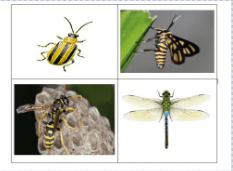 Bugs Spring has sprung and the bugs are out exploring all the nature spaces! Study this photo of 4 bugs. Which one do you think doesn’t belong? How do you know this? How are the bugs the same? Can you draw one of the bugs and label the parts of the bug you know? Ask a family member what bug is their favourite and why! |
| Problem Solving and Innovating | Bug Sculptures!
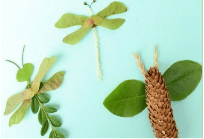 Bug Sculptures Can you make a sculpture of an insect with nature materials? What insect will you make? What materials will you need? While you are outside, collect materials for your sculpture. Create and share it with others in your home. Check out the examples of flying bugs. I WONDER what creepy, crawly insects would look like? |
| Self-Regulation and Well-Being | Take a walk or look out your window. Do a survey on paper of how many different types of trees, birds and animals you see. Did you see more birds than animals? How many trees did you see? Was it more than 10 or less than 10? Draw a picture of something from your walk and label. |
Tuesday
Optional Read Aloud: Chicka Chicka Boom Boom by Bill Martin Jr.
| 4 Frames | Learning Opportunities |
| Belonging and Contributing | This or That is a talking game where players choose which of two items they prefer. To play, choose someone in your home to play with. Read the two words and choose which you prefer. Tell your play partner why you chose that answer.
Rabbit or Giraffe |
| Demonstrating Literacy and Mathematics Behaviour |  Let’s Talk About It! Using the picture provided, share a story about what is happening in this picture with someone in your home. Use the following questions to add supporting details to your story: What/Who do you see? What happened before this picture was taken? What do you think will happen next? Writing extension: On a piece of paper, label and/or write a sentence to represent your story. Let’s Talk About It! Using the picture provided, share a story about what is happening in this picture with someone in your home. Use the following questions to add supporting details to your story: What/Who do you see? What happened before this picture was taken? What do you think will happen next? Writing extension: On a piece of paper, label and/or write a sentence to represent your story.
Comparing Heights |
| Problem Solving and Innovating | Water Challenge Fill up a container, tub or sink with water. You will need two bowls or containers the same size (one for you and one for someone else). Find items you could use for scooping (e.g., measuring cup, small bowl, ladle, spoon). You might want to have a towel nearby to dry up any spilt water! Challenge someone in your home to fill the bowl using the scooping items. First, use your hands to cup the water and put it in the bowl. Who was able to fill the container first? How many scoops did it take to fill the bowl? Would you do anything different the next time? Play again using the different scooping items. |
| Self-Regulation and Well-Being | Balance Beam Create a line on the floor with tape, chalk or string (or anything else you have). Inside or outside with a grownup. Pretend you are an animal that is looking for food on a tree. While balancing on your line bend and pretend to pick up food. Can you make it easier or harder by changing the direction or shape of your line? If you live near a forest and see fallen down tree, you could walk on it from one end to the other (safely and with a grown up!). |
Wednesday
Optional Read Aloud: Giraffe Problem by Jory John
| 4 Frames | Learning Opportunities |
| Belonging and Contributing | This or That is a talking game where players choose which of two items they prefer. To play, choose someone in your home to play with. Read the two words and choose which you prefer. Tell your play partner why you chose that answer.
Broccoli or Green Beans |
| Demonstrating Literacy and Mathematics Behaviour | Wednesday Word Hunt: Using the letters in the word WEDNESDAY, find objects around your house that represent the beginning sound of each letter. Write down the objects/tell a grownup the objects you have found! For example: W (watch), E (egg), D (door), etc.Extension: Challenge yourself to find 3 items for every letter of the word Wednesday or play again with your favourite day of the week! 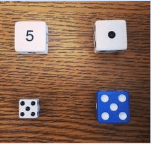 Four Dice What does not belong? Look at the photo of the dice. What do you notice? What makes all the items alike? What makes them different? Which one doesn’t belong? Explain your thinking. |
| Problem Solving and Innovating | Make your own paint brush!
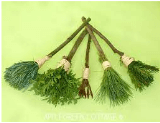 Handmade Brushes During your next walk, collect a variety of nature materials (e.g., twigs, pine needles, foliage). Use the twigs to create a handle and the needles and/or foliage to create the brush. To attach the two together you could use a rubber band or string. Then, fill a small container with water and use your paintbrush to paint something (e.g., bricks on your home, the sidewalk, a park path, a fence). |
| Self-Regulation and Well-Being | Flip a Coin Workout You will need a coin to start (any coin will do – penny, nickel, quarter, loonie!). Then write down 5 exercises (e.g., push up, jumping jack, touch your toes etc.) that you know. Flip the coin and perform the exercise matching the coin until the time ends. You could use a timer or just count to 15. There are 5 rounds. Each round will be a 15 second exercise and then a 15 second rest. During the rest time you will flip the coin again to decide on the next exercise. Have fun and don’t forget to breathe! |
Thursday
Optional Read Aloud: Hooray for You by Marianne Richmond
| 4 Frames | Learning Opportunities |
| Belonging and Contributing | This or That is a talking game where players choose which of two items they prefer. To play, choose someone in your home to play with. Read the two words and choose which you prefer. Tell your play partner why you chose that answer.
Be a Chair or a Table |
| Demonstrating Literacy and Mathematics Behaviour | Rhyming Basket Song:
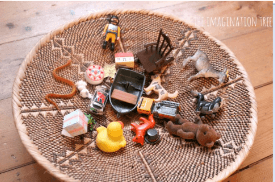 Bunch of Stuff A tisket, a tasket, Tic Tac Toe |
| Problem Solving and Innovating | Problem Solving! Your friend has lost their favourite toy. How will you help them to find it? How will you help them to feel better? Extension: An adult in your family asks for your help to bake a cake. What do you know about baking? How could you help them? Draw a picture to show your thinking. |
| Self-Regulation and Well-Being | What can you see? Bring a piece of paper/pencil on your walk today. During the walk count how many birds you see. Tally the birds you saw (e.g., 4 birds = llll). What about animals on your walk? Did you see any? Tally the animals you saw (e.g., 2 dogs = ll). Extension: draw your favourite bird or animal that you saw. Can you label the bird/animal? Share your work with someone. |
Friday
Optional Reading Aloud: A Dog is a Dog by Stephen Shaskan
| 4 Frames | Learning Opportunities |
| Belonging and Contributing | This or That is a talking game where players choose which of two items they prefer. To play, choose someone in your home to play with. Read the two words and choose which you prefer. Tell your play partner why you chose that answer.
Be a Dragon or a Unicorn |
| Demonstrating Literacy and Mathematics Behaviour | Concentration Game with letters or words! Cut up or rip pieces of paper with each letter of the child’s name (written twice for pairing) to create cards. Place the cards face down on a table. Each player turns over two letters and reads them. If the child is working on identifying letters, they can say the letter name. If the child is working on saying letter sounds, they can say the letter sound. If a match is made the player keeps the cards and gets another turn. Play until all the cards have been collected. Extension: Continue with play with different letters of the alphabet or high frequency words (e.g., no, is, can, me, you, and, he, at, a, so, on, in, up, am, we, like, see, I, go, it, do, an, the, my, to).Number Hunt Using a newspaper, magazine and/or recyclable materials go for a number hunt. Look through the materials to search for the numbers 1 through 20. When you find a number, cut it out using scissors (or rip with your hands). Keep going until you find all 20 numbers. When you are finished the hunt put the numbers in order. |
| Problem Solving and Innovating | Living Vs. Non-Living With someone in your home, talk about living versus non-living things. Are the following living or non-living? A rock, a flower, a soccer ball, a tree, a bug, a puppy, a worm, a car, cookies? How do you know if something is living? Write a list of ideas (e.g., it grows). What are some things that all living things have in common? After your discussion, go for a walk and look for living and non-living things and talk about how you know that. |
| Self-Regulation and Well-Being | Thank You! Do a good deed today. Draw or create a message of thanks in chalk for others to see (e.g., on the driveway, path at the park) or make a card or note and deliver to someone you know (e.g., a neighbour, a friend, someone in your home). |
Monday
Optional Read Aloud: Dragons Love Tacos by Adam Rubin
| 4 Frames | Learning Opportunities |
| Belonging and Contributing | All About You! Collect natural materials (e.g., twigs, stones, acorns, pinecones etc.) and build your name. Can you create someone else’s name? A friend? A family member? Someone important to you? |
| Demonstrating Literacy and Mathematics Behaviour |
 Dog Reporter Let’s Talk About It! Using the picture provided, share a story about what is happening in this picture with someone in your home. Use the following questions to add supporting details to your story: What/Who do you see? What happened before this picture was taken? What do you think will happen next? Writing extension: On a piece of paper, label and/or write a sentence to represent your story. What’s Missing? |
| Problem Solving and Innovating | Rescue You will need a container that can go in the freezer. Collect a variety of objects and then put them in the container with water. Some possibilities – flowers, dandelions, LEGO pieces, small toys, coins, buttons, etc. Then, put the container in the freezer. After the objects are frozen, provide the child with the opportunity to experiment and explore with different water temperatures to “rescue” what’s been frozen in ice. Extension: Have them guess how long it will take to melt. |
| Self-Regulation and Well-Being | Sit Spot A sit spot is a child-selected space where he or she can observe nature return to regularly to notice how nature changes over time. Choose a sit spot where you can sit and observe your surroundings. This might be the same window spot in your home or a bench at the park. Go to your sit spot and notice what is happening around you. What do you see? What do you hear? What do you smell? What do you feel? |
Tuesday
Optional Read Aloud: How Rocket Learned to Read by Tad Hills
| 4 Frames | Learning Opportunities | ||||
| Belonging and Contributing | All About You! Draw an outline of a t-shirt on a blank piece of paper or print an online template. Together, brainstorm positive words that can be used to describe people (e.g., smart, funny, kind, happy, hardworking, gentle). Ask the child what characteristic(s) they feel are most like them. Then, provide the child with the t-shirt template and have them write the characteristic(s) they chose and on the t-shirt template and design it. Help them with writing as needed. If available, provide a variety of art supplies to decorate the t-shirt template. |
||||
| Demonstrating Literacy and Mathematics Behaviour | Letter/Sound Sort: Play this game with a grownup! The grownup will read each word and stretch out the sounds (e.g., s-o-ck). Ask the child, “where do you hear the /k/ sound? At the beginning of the word? Or the end?
Words to sort: sock, king, kite, truck, kangaroo, key, lock, book, bank, koala Extension: Play this game again with the first letter/sound in your name. Nature Shapes |
||||
| Problem Solving and Innovating | Sink or Float? Guess whether the object will sink or float and then discover by putting different items in water to see if they are correct. Collect a variety of small items from around your home. Indoors, children can do this activity at the kitchen sink, in the bathtub or on the floor with a tub or basin filled with water. The activity can also be done outside in a kiddie pool or any container that can hold water. Extension: Keep a simple tally chart to record your thinking. How many items sink? How many items float? |
||||
| Self-Regulation and Well-Being | Stretch and Move Your Body Invite someone in your home to move and stretch with you! What different ways does your body move? Can it stretch? Can it bend? Can it reach? Here is a challenge! I wonder if you can s-t-r-e-t-c-h your name! Try and shape your body to each letter in your name (e.g., if you have an L in your name bend and move your body to try and make the letter L). |
||||
Wednesday
Optional Read Aloud: I Am Brown by Ashok Banker
| 4 Frames | Learning Opportunities |
| Belonging and Contributing | All About You! Have a discussion with someone in your home. How many people are in your family? Can you show the number with your fingers? Can you draw the number in the air? Can you clap the number with your hands? Can you stomp the number with your feet? Draw a picture of you and your family. Label the people in your family. |
| Demonstrating Literacy and Mathematics Behaviour | I Hear with my little Ear Play a variation of the game I Spy, changing it to I Hear. The grownup will find objects in the room for this game. For Example: Grownup: I hear with my little ear something that rhymes with ‘moon’ (and you can eat cereal with it). Child: Spoon Possible word list: moo-shoe, mable-table, head-bed, call-ball, boy-toy, clock-sock, etc.Making Nature Soup All you need to make this soup is a variety of nature items, a few kitchen tools and water. Collect the nature items on a walk or during play time at the park. Follow the recipe: 1 mixing bowl, 1 big spoon, ½ cup of dirt, ½ cup of stones, 1 cup of weeds, 1 cup of fallen items from a tree or bush and 3 cups of water. Mix the items in the bowl. During play, ask these questions:
|
| Problem Solving and Innovating | Rock Balancing Rock balancing is when stones are stacked on top of the other to create land art without using anything to stick it together or hold it upright. Collect a variety of rocks that are different sizes and shapes. Find a safe space to build with your rocks. Grownups might ask; tell me about how you decided to build your structure, what made you choose these rocks to build this way? How do you think you could make it taller? Wider? What do you like about your structure? What would you do different next time? |
| Self-Regulation and Well-Being | Mirror Mirror Play this action game with someone in your home. Choose one person to be a leader and then face each other. The leader will do an action (e.g., put one hand on your head and one hand on your belly) and the other person will try to do the same action. Try different actions. Looking for a challenge? Try and hold different body positions while standing on one leg or sitting on the floor. Change roles and play again. |
Thursday
Optional Read Aloud: How to Read a Story by Kate Messner
| 4 Frames | Learning Opportunities |
| Belonging and Contributing | All About Me! Think about the fun things you do with your family. Is there something that you and your family celebrate? Draw a picture of you and your family celebrating your favorite holiday/celebration. Why is this holiday/celebration your favourite? |
| Demonstrating Literacy and Mathematics Behaviour | Go Fish! Preparation: From the following Kindergarten word list, write 10 high frequency words on cards: no, is, can, me, you, and, he, at, a, so, on, in, up, am, we, like, see, I, go, it, do, an, the, my, to. You will need two sets of words which creates a set of 20 cards. Play by dealing 4 cards to each player. The remaining cards are placed face down in the middle of the table. Player 1 asks another player if they have a word. If they have it, they give it to the player, if not they say, “Go Fish!” and the player selects a new card. If a match is made the player continues with their turn. The game finishes when one player has found a match for all their cards.Sorting by Texture Collect a variety of items from around your home or outside. Look for items that feel different (e.g., sandpaper, tree bark, a brush, stones, silky cloth, a book, etc.). Lay the items in front of the child and then try and sort or group them by how they feel (texture) – rough and smooth. Optional – you could add sorting rings by using two loops of yarn or string, two placemats, two bowls or two pieces of paper. Grownups might ask: why did you put this item with the rough group? (e.g., because it feels prickly, because it is not smooth, because it feels rough and scratchy) or why did you put this item with the smooth group? (e.g., it is soft, it is not prickly). Extension: Practice sorting laundry, silverware, groceries, toys, or shoes. |
| Problem Solving and Innovating | What’s Inside? Go on a “search and find” with someone in your home. Look for household items and put them in a bag, box or sock. Some items might include: a hairbrush, comb, kitchen utensil, soap, toys, fruits, vegetables. What’s inside? Begin to take turns with someone in your home first by feeling the item (without looking) and then guessing what it is. Was your guess correct? If so, how did you know what the item was? |
| Self-Regulation and Well-Being | Let’s practice how to calm our body. Breathing is a great way to help calm the body and the brain. Take a deep breath in and like you’re smelling a beautiful flower. Breathe out like you’re blowing out candles on a cake. Does your belly fill up with air? Do you feel your body calming? Repeat breathing until you feel calm. |
Friday
Optional Reading Aloud: E-Mergency by Ezra Fields-Meyer
| 4 Frames | Learning Opportunities |
| Belonging and Contributing | All About Me! Look in the mirror. Discuss what you see and the things that make you unique and special. Create movements based on different feelings. Ask your child how to move their body if they were sad, happy, upset, angry, excited, scared, nervous, sick, tired. |
| Demonstrating Literacy and Mathematics Behaviour | Rhyming Sing Song
Down by the Bay (Song by Raffi) Search and Find |
| Problem Solving and Innovating | What would you do? Have a grownup ask you the following questions:
|
| Self-Regulation and Well-Being | Sound Walk Go on a sound walk around your neighbourhood, the local park or your yard and see how many different things you hear. Can you check off all these sounds?
|
Monday
Optional Read Aloud: The Rabbit Listened By: Cori Doerrfeld
| 4 Frames | Learning Opportunities | ||||||
| Belonging and Contributing |
 Swimming Dog Picture of the Day: Take a minute to look at the photo. With someone in your home discuss: What is happening in the photo? What makes you say that? |
||||||
| Demonstrating Literacy and Mathematics Behaviour | Rhyme Detective While going for a walk outdoors (or walk around your home) look for and name ten objects. Make up a rhyming word for each object you found. These words can be real or nonsense words (e.g., chair-bear; floor-more; window-bindow, tree-me)! Take turns with someone and see how many rhymes you can come up with together. Extension: Bring something to write on and a pencil on your walk. Write down the objects you found. Try and put these words into sentences. Choose one of the objects you found and draw a picture of all the things you can think of that rhymes with that word.Favourite Summer Activity There are lots of fun things to do outside in the summertime. Make a list of 3 activities you can do in the summer. Ask the people in your home and around you what their favourite summer activity is. Make a tally chart about this.For example:
What do people like to do the most? What do people like to do the least? |
||||||
| Problem Solving and Innovating | Chair Soccer Prepare your area for play. Choose an area where there is enough space to kick along the ground. Remove breakable items. Set the game up based on the space you have. You can always move closer or further away to make it easier or harder. Set up 2 chairs across from each other about 3-4 metres apart. Find someone to play against. You can also play alone with one chair, a stool or make a goal of your own. Make sock balls. Roll a sock inside itself to make a ball. You can also use a paper ball. Using the sock or paper ball, accurately kick the ball through the legs of the chair. Play! Taking turns, each player kicks from a pre-determined spot. Points are awarded each round.1 point if the ball hits a leg of the chair but does not go under or through 2 points if the ball comes to a stop under the chair 3 points if the ball goes completely through the legs of the chair and out the other sidePlay until someone reaches a score of 21. Or play with no score and have a winner every round. Or just play for fun! |
||||||
| Self-Regulation and Well-Being | Swaying Trees Sit tall or stand with your feet apart. Balance evenly on both feet if standing. Keep your eyes open. Imagine you are a tree in the wind, and your arms are the branches. Swing your arms side to side like swaying branches. Bend forward at the waist and keep swaying your arms. Come up slowly, continually swaying your arms side to side. Bend and sway until you feel as free as a tree moving in a light breeze. Finish by taking three soft, slow breaths. Does your body feel different than it did before the exercise? |
Tuesday
Optional Read Aloud: Love Is By: Diane Adams
| 4 Frames | Learning Opportunities |
| Belonging and Contributing |
 Big Hug! Picture of the Day: Take a minute to look at the photo. With someone in your home discuss: What is happening in the photo? What makes you say that? |
| Demonstrating Literacy and Mathematics Behaviour | Syllable Fun! Say or write down the names of 10 classmates from your class. Say your classmate’s names out loud. As you say the name try to jump the syllables (e.g., Sam = 1 jump, Gurpreet = 2 jumps). Can you do the same with the names of the members in your family? Extension: Look around your home. Draw pictures of objects that have 2 syllables. On another page, draw pictures of objects that have 3 syllables. 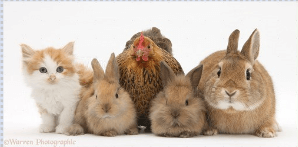 Best Friends! Which One is Different? Look at the photo of different kinds of animals. What is the same about them? What is different about them? Which ones do you think belong together? Explain why you think that. Which ones do you think do not belong together? Explain. |
| Problem Solving and Innovating | Obstacle Course Create an obstacle course with someone in your home. This is a great way to explore materials, express creativity and move your body. You will need a variety of materials to build your obstacle course. Take a look around your home and what is safe to use. Examples might be putting tape on the floor as a balance beam, crawling under a table, climbing over a chair, using pillows as stepping stones. Do you have a park or forest near your home? Look for natural materials or park equipment that you can use to practice climbing, jumping and balancing on. |
| Self-Regulation and Well-Being | Hop and Jump! Find a spot in your home to start (e.g., front door of your home, bedroom door). Stand still and decide where you want to go next (e.g., bathroom, bedroom, kitchen). Begin jumping on two feet to get to your destination. When you get there tell someone in your home how many jumps it took to get there. Try a new destination! How many jumps did that take? Extension: Hop on one foot from one destination to another. How many hops did it take to get there? Try and count by 2’s as you hop or jump to your next destination. |
Wednesday
Optional Read Aloud: The Day the Crayons Quit By: Drew Daywalt
| 4 Frames | Learning Opportunities |
| Belonging and Contributing |
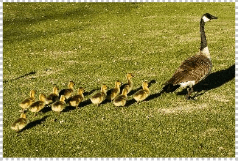 Follow the Leader Picture of the Day: Take a minute to look at the photo. With someone in your home discuss: What is happening in the photo? What makes you say that? |
| Demonstrating Literacy and Mathematics Behaviour | Concentration Cut up or rip pieces of paper with each letter of the child’s name (written twice for pairing) to create cards. Place the cards face down on a table. Each player turns over two letters and reads them. If the child is working on identifying letters, they can say the letter name. If the child is working on saying letter sounds, they can say the letter sound. If a match is made the player keeps the cards and gets another turn. Play until all the cards have been collected. Extension: Continue with play with different letters of the alphabet or high frequency words (e.g., no, is, can, me, you, and, he, at, a, so, on, in, up, am, we, like, see, I, go, it, do, an, the, my, to).Shape Challenge You will need two coloured pencils for this activity. If you don’t have red and green choose 2 colours you do have. Pick 2 numbers between 1-10. The first number you picked, draw that many circles in red. The second number you picked, draw that number of circles in green. How many circles do you have total? Do you have more red circles or green circles. How do you know? Now try drawing squares! Pick 2 numbers between 1-10. The first number you picked, draw that many squares in red. The second number you picked, draw that number of squares in green. How many squares do you have total? Do you have more red squares or green squares. How do you know? For a bigger challenge choose 2 numbers between 1-20. |
| Problem Solving and Innovating | What can you build? There are many items around the house that can be used to build. Examples you might find around the home could be boxes (e.g., shoebox, Kleenex, cereal, packing), empty pringles can, empty paint tins, sponges, plastic cups. Adding play materials like vehicles, stuffed animals, small toys, natural items (e.g., pebbles, pinecones, acorns) can enhance block play. Can you make a plan? Write or draw that plan on a piece of paper or tell someone in your home. Explore the items you collected. |
| Self-Regulation and Well-Being | Close your Eyes See how long you can keep your eyes closed. What do you think about when your eyes are closed? Can you see anything? How does your body feel when your eyes are closed? |
Thursday
Optional Read Aloud: I Wish You More By: Amy Krouse Rosenthal
| 4 Frames | Learning Opportunities | |||||||||
| Belonging and Contributing |
 Fireworks! Picture of the Day: Take a minute to look at the photo. With someone in your home discuss: What is happening in the photo? What makes you say that? |
|||||||||
| Demonstrating Literacy and Mathematics Behaviour | Syllables in Spring! Using the list of spring words, clap the syllables for each word. Sort them into categories based on the number of syllables they have.
 Pencils Patterns |
|||||||||
| Problem Solving and Innovating | Guess Who This game involves guessing what the other person is pretending to be. Ask the child to choose an animal (but not say what they chose). Ask the child to think about the way the animal moves. Encourage the child to move like the animal they have chosen. Try and guess what the animal is. Take turns to move like different animals. Ask each other questions to help you guess. Try playing the game using different people you know, fruits and vegetables, places, rooms in the home. | |||||||||
| Self-Regulation and Well-Being | The Five Senses Seeing, hearing, smelling, tasting, touching, and feeling are the five senses. We use these five senses to learn about the world and what is happening around us. Take a walk around your home (inside and/or outside).
|
Friday
Optional Reading Aloud: Little Pea By: Amy Krouse Rosenthal
| 4 Frames | Learning Opportunities | ||||
| Belonging and Contributing |
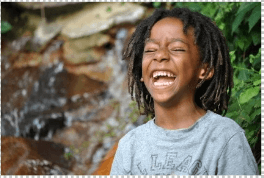 Laughing! Picture of the Day: Take a minute to look at the photo. With someone in your home discuss: What is happening in the photo? What makes you say that? |
||||
| Demonstrating Literacy and Mathematics Behaviour | Letter/Sound Sort: Play this game with a grownup! The grownup will read each word and stretch out the sounds (e.g., ch-i-p). Ask the child, “where do you hear the /ch/ sound? At the beginning of the word? Or the end?”
Words to sort: chip, bench, chart, lunch, beach, cheese, chop, touch, march, chair Extension: Play this game again with the first letter/sound in your name. Counting Around the Home |
||||
| Problem Solving and Innovating | Song Writing Write a song or story cooperatively with someone in your home. Each person writes only one word at a time with no talking or planning until you feel you have enough to create a song/story. Silly songs and stories are encouraged! Perform your song or read your story! |
||||
| Self-Regulation and Well-Being | Cross Crawl Stand with feet shoulder-width apart. Begin to march on the spot in a relaxed way. Once you get that rhythm, touch each raised knee, in turn, with your opposite hand. If possible, continue until it feels like an easy walking rhythm. This is great for grown-ups too! |
||||
Monday
Optional Read Aloud: Golden Threads By: Suzanne Del Rizzo
| 4 Frames | Learning Opportunities | ||||
| Belonging and Contributing | Question of the Day can build confidence, promote conversation, and nurture communication skills. Possible times to ask the question of the day could be in the morning, before breakfast, or every night during dinner.
What are 3 things you like about yourself? |
||||
| Demonstrating Literacy and Mathematics Behaviour | Letter/Sound Sort Play this game with a grownup! The grownup will read each word and stretch out the sounds (e.g., sh-i-p). Ask the child, “where do you hear the /sh/ sound? At the beginning of the word? Or the end?”
Words to sort: ship, shell, wish, fish, sheep, shirt, shower, brush, flush, dish Extension: Play this game again with the first letter/sound in your name. Number Battle
How to Play:
|
||||
| Problem Solving and Innovating | Operation Practice using your hand muscles by picking up small items in this game called Operation. With the help of a grownup look for kitchen tongs (or 2 large spoons or 2 books) and some small objects, which you arrange in your space or playing area. The grownup will hand the child the tongs and ask them to carefully pick up each item with the tongs. For a challenge, try using tweezers. Extension: Pick items up and carry them a distance to place in a box, bowl or another space. |
||||
| Self-Regulation and Well-Being | Drums Use a plastic ice cream or yogurt container with a lid. Make four holes in the container: one on each side of the container (just below where the lid sits) and one on each side of the lid. With the lid off, but positioned close to the top of the container, simply thread a long piece of wide ribbon or string through the holes. Snap the lid in place and knot the ends of your ribbon. Add a couple of chopsticks, spoons or sticks and play. You can also use upside down boxes, pots, clean cans, etc. |
||||
Tuesday
Optional Read Aloud: Nathan Saves Summer By: Gerry Renert
| 4 Frames | Learning Opportunities |
| Belonging and Contributing | Question of the Day can build confidence, promote conversation, and nurture communication skills. Possible times to ask the question of the day could be in the morning, before breakfast, or every night during dinner.
What do you like to do for fun? |
| Demonstrating Literacy and Mathematics Behaviour |
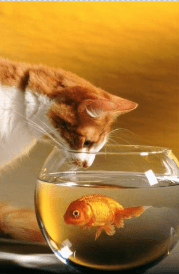 Hello, there! Let’s Talk About It! Using the picture provided, share a story about what is happening in this picture with someone in your home. Use the following questions to add supporting details to your story: What/Who do you see? What happened before this picture was taken? What do you think will happen next? Writing extension: On a piece of paper, label and/or write a sentence to represent your story. I Spy! |
| Problem Solving and Innovating | Around the World Prepare your area for play. Choose an area where there is enough space to throw or toss. Remove breakable items. Set the game up based on the space you have. You can always move closer or further away to make it easier or harder. Set up an open container like a laundry basket or box in the middle of your space. Place 5 markers or toys around it in a circle. Make sock balls. Roll a sock inside itself to make a ball. You can also use a paper ball. Play! Start at one spot and use the ball you made to shoot/toss from that spot until you get it in the basket. Move to the next spot and repeat until you make it around the world (until you get it in from every spot). Extension: Count how many shots it took to make it around the world. |
| Self-Regulation and Well-Being | Silly Drawing Spark your imagination and get your creative mind working:
Extension: Create your own silly drawing idea and write it down for someone else to try. |
Wednesday
Optional Read Aloud: And You Can Come Too By: Ruth Ohi
| 4 Frames | Learning Opportunities |
| Belonging and Contributing | Question of the Day can build confidence, promote conversation, and nurture communication skills. Possible times to ask the question of the day could be in the morning, before breakfast, or every night during dinner.
If you can choose to eat only one food for the rest of the year, what would it be? |
| Demonstrating Literacy and Mathematics Behaviour | Clues, Clues, Clues! Gather 10 items from around your home and hide them under something like a towel (e.g., a spoon or a toy). For each item, clap the syllables, say something that rhymes, tell what sound it starts with and what sound it ends with and stretch out all the sounds. See if you can give clues about each object to someone in your home. Are they able to guess your hidden objects?Math Walk and Talk Go for a walk around the neighbourhood with a grownup and look for math all around you! Pay attention to things in nature, architecture and what’s in the sky and on the ground! Some examples could be:
|
| Problem Solving and Innovating | Shadow Drawing
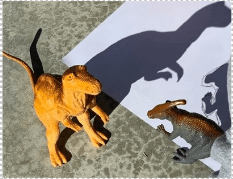 Dino Shadows You will need find a comfortable spot to draw either inside your home or outside if it is sunny. Collect a variety of objects (e.g., toys, Lego, dinosaurs etc.) that you want to trace the shadows of. To trace the objects, use paper and a pencil, or you can use sidewalk chalk. What do you notice about the traced objects compared to the actual object? |
| Self-Regulation and Well-Being | Tic Tac Toe
|
Thursday
Optional Read Aloud: Little Book of Big Fears By: Monica Arnardo
| 4 Frames | Learning Opportunities |
| Belonging and Contributing | Question of the Day can build confidence, promote conversation, and nurture communication skills. Possible times to ask the question of the day could be in the morning, before breakfast, or every night during dinner.
What do you want to be when you grow up? |
| Demonstrating Literacy and Mathematics Behaviour | Sight Word Showdown!
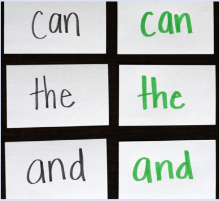 Sight Words To play this sight word game, use index cards or pieces of paper and markers. Pick 6 high frequency words (e.g., words that frequently appear in your child’s books). For example, and, go, me, to, be, can, went, the, etc. Write each one on a separate index card. Then, using a different colored marker, write the same 6 words on separate index cards. Give the child one set of cards and ask them to spread the cards out in front of them. Before playing, point to each word and read them out loud. Then, the grownup can mix up their deck of cards and randomly pick one and read it out loud (without revealing the word). The child will then scan the list of words in front of them and find the match and hold it close to their chest. When your child is ready, call out together “1-2-3 SHOWDOWN!” and put your words down at the same time and see if it is a match! Continue playing until all the cards have been matched. Estimation Takes Practice! |
| Problem Solving and Innovating | Create your own Mud! This is a fun activity to do outside. You will need a big bowl or large plastic container and measuring cups that can get dirty or use safe recyclables that you can scoop with (e.g., plastic yogurt container).Recipe:
How to Make Mud
|
| Self-Regulation and Well-Being | Feelings
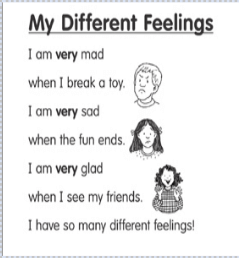 Different Feelings Do you find it difficult sometimes to figure out how you are feeling? Sometimes we need to slow down and think about it. How can you slow down and think about your feelings? What makes you feel calmer or happier? Take a peek in the mirror. See how you look when you feel happy, sad, angry, silly, scared, excited, or any other emotion. What do you notice? |
Friday
Optional Reading Aloud: ABC Letters in the Library By: Bonnie Farmer
| 4 Frames | Learning Opportunities | ||
| Belonging and Contributing | Question of the Day can build confidence, promote conversation, and nurture communication skills. Possible times to ask the question of the day could be in the morning, before breakfast, or every night during dinner.
Describe a moment where you felt the happiest? |
||
| Demonstrating Literacy and Mathematics Behaviour | Musical Movement with Words Find some plain paper and cut them into cards. Write the letters of the word S U N S H I N E on them. Place them around a room with the furniture pushed aside, so there is room to move and groove when the music plays. Play music of your choice and groove. The grownup will pause the music and CALL out the sound the letter makes. Your child will find the letter that matches the sound and will stand on that letter. Repeat until you have discovered all the sounds! Extension: Play again using the word OUTSIDE, UMBRELLA, ADVENTURE, etc.Jumping Bean Label pieces of paper from 1 to 20. Fold the paper and place like a tent so they won’t slide if stepped on. Place the numbered papers on the floor (or outside on the grass) like a maze. Try jumping between the papers in numerical order, trying not to touch the ground. Be sure the papers are spaced so the child can jump between them safely. Can you complete the course backwards? Have someone call out random numbers and jump over the corresponding papers. |
||
| Problem Solving and Innovating | Build a Fort Using different items around the home (e.g., pillows, table, couch, sheets) build a fort. Some prompting questions for the grownup to ask during and after the build. How big can you make your fort? How many rooms does your fort have? How many entrances? What is the name of your fort? Who is allowed in your fort? |
||
| Self-Regulation and Well-Being | Spring Drawing Draw pictures of things that remind you of springtime! Can you title your drawing? Can you label your drawing? Can you share your drawing with someone in your home? Tell them how you know it is spring!
|
Monday
Optional Read Aloud: Hair Love by Matthew A. Cherry
| 4 Frames | Learning Opportunities |
| Belonging and Contributing | Would You Rather? A “Would You Rather” question is a wonderful way to engage in some critical thinking. Read the question with the child and discuss both options and invite the child to state which option they choose and why.
Would you rather be a detective or a pilot? |
| Demonstrating Literacy and Mathematics Behaviour | Mystery Bag Place 10 common items into a bag (e.g., ball, hat, can, mitten, coin, spoon, pencil, book, etc.). Have the child reach into the bag and try to guess what it is by feeling it. After the child guesses the mystery object, have them take it out of the bag. Ask the child to think of words that rhyme with the object (ball – call, hall, mall, fall, tall, wall, etc.). It is okay if the words are nonsense words.Number Hunt Cut up 20 small pieces of paper and write the numbers 1-20. You may choose to use dots instead of numbers or a combination of both. Put the numbers in different places around the house and send the child on a hunt. Each time they find one, read the number aloud, copy it onto a piece of paper, or bring the number to you. Extension: Once they have found all the pieces, have them put the numbers in order and create a number line. |
| Problem Solving and Innovating | Bubbles Add some dish soap to water. Explore the bubbles – feel them, look at them or leave some bubbles on a surface for the child to explore in their own time. Talk about what is happening to the bubbles as they touch and move them about. How do they feel? What happens when they burst? What happens if we add more water?*Supervision is always needed when a child is playing with or near water.Extensions: Practice washing toys or plastic dishes or containers. Add items to the water. Dish soap, laundry detergent, hand soap or food colouring will change the appearance and texture of the water. Use this opportunity to discuss important topics for example, hand hygiene and water safety. |
| Self-Regulation and Well-Being | Music with Sticks Look outside for 2 sticks to tap together or use anything you may have at home. For example, wooden spoons, pencils, wooden dowels, etc. Then, find a catchy tune to tap along to. Try tapping out the alphabet or do some counting. Extension: What else can you do with 2 sticks? |
Tuesday
Optional Read Aloud: Going Up! By Sherry J. Lee
| 4 Frames | Learning Opportunities |
| Belonging and Contributing | Would You Rather? A “Would You Rather” question is a wonderful way to engage in some critical thinking. Read the question with the child and discuss both options and invite the child to state which option they choose and why.
Would you rather swing on a swing or fly a kite? |
| Demonstrating Literacy and Mathematics Behaviour |
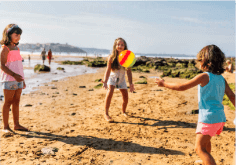 At the Beach Let’s Talk About It! Using the picture provided, share a story about what is happening in this picture with someone in your home. Use the following questions to add supporting details to your story: What/Who do you see? What happened before this picture was taken? What do you think will happen next? Writing extension: On a piece of paper, label and/or write a sentence to represent your story. Name Game |
| Problem Solving and Innovating | Can you solve this problem? I was standing on the sidewalk, and I counted six cars going by. Three of the cars were red. The rest of the six cars were blue. How many cars were blue? How do you know this? Extension: Can you show that number using your fingers? Can you write that number on a piece of paper? Can you show that number in a different way? |
| Self-Regulation and Well-Being | High Five! Trace your hand on a piece of paper. On each finger write something that you like about yourself. Once completed, stick the hand up somewhere that you can see it and reach it. Throughout the day give your hand a high-five every time you pass it in your home. |
Wednesday
Optional Read Aloud: All Are Welcome By Alexandra Penfold
| 4 Frames | Learning Opportunities | ||||
| Belonging and Contributing | Would You Rather? A “Would You Rather” question is a wonderful way to engage in some critical thinking. Read the question with the child and discuss both options and invite the child to state which option they choose and why.
Would you rather sing or dance? |
||||
| Demonstrating Literacy and Mathematics Behaviour | Letter/Sound Sort Play this game with a grownup! The grownup will read each word and stretch out the sounds (e.g., th-a-t ). Ask the child, “where do you hear the /th/ sound? At the beginning of the word? Or the end?”
Words to sort: that, with, think, earth, month, tooth, thin, they, them, bath, sloth, thumb, three, thirteen Extension: Play this game again with the first letter/sound in your name. What season is your favourite? |
||||
| Problem Solving and Innovating |
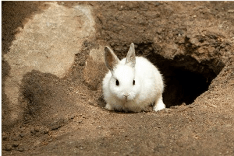 White Rabbit Be a Rabbit! Write a story from the perspective of a rabbit going down a hole. What does the rabbit experience? see? feel? hear? |
||||
| Self-Regulation and Well-Being | Tissue Dance Dancing and moving your body is a great way to get exercise and help support how you are feeling. You will need a tissue (or paper of any kind) to play this game. Place the tissue on your head. Play some music (or sing!) and begin dancing. Don’t let the tissue fall off your head. No hands! Think about what position your body needs to be in to balance the tissue? How does your technique change with the different speed of the music? Try balancing different objects, what do you notice? |
||||
Thursday
Optional Read Aloud: What Pete Ate from A-Z By Maira Kalman
| 4 Frames | Learning Opportunities |
| Belonging and Contributing | Would You Rather? A “Would You Rather” question is a wonderful way to engage in some critical thinking. Read the question with the child and discuss both options and invite the child to state which option they choose and why.
Would you rather it be warm and raining or cold and snowing today? |
| Demonstrating Literacy and Mathematics Behaviour | Alphabet Home Hunt Part 1: We hope you have had the chance to listen to the story ‘What Pete Ate from A-Z’. You can find the link at the top of this day. This activity is inspired by the book. On small index cards, sticky notes or cut up pieces of paper, write out the letters: A, B, C, D, E, F, G, H, I, J, K, L, M to make ‘letter labels’. Explore your home with the letter cards and look think about the beginning sounds that objects and items in your home begin with. When you find an item that matches the beginning sound of a letter in your hand, leave the letter label there. For example: place the L card on the LAMP, place the D card on the DOOR.Numbers With a grownup, look at a variety of store flyers. Can you find the numbers 1 to 20? Using scissors (or rip the paper) cut out the numbers you find and glue them (or place them) in order on a sheet of paper. |
| Problem Solving and Innovating | Spoon Balance Find a space to play this movement game inside or outside your home. Be sure to choose an area that you will be safe as you walk fast or run. Next, collect a few small objects (small balls, cotton ball, wood chip, pebbles etc.). Have each person who is playing hold a spoon in front of them and balance the object on the spoon. Decide where the start and finish line is. Start moving and try to keep the object on your spoon! What went well? What would you do different? Play again! |
| Self-Regulation and Well-Being | Homemade Puzzles:
Extension: Try to put the puzzle back together as quickly as possible. You could try to race other people in your home or beat your own time. |
Friday
Optional Reading Aloud: My Heart Fills with Happiness by Monique Gray Smith
| 4 Frames | Learning Opportunities | |
| Belonging and Contributing | Would You Rather? A “Would You Rather” question is a wonderful way to engage in some critical thinking. Read the question with the child and discuss both options and invite the child to state which option they choose and why.
Would you rather be able to hold your breath for as long as a whale or be able to jump as far as a kangaroo? |
|
| Demonstrating Literacy and Mathematics Behaviour | Alphabet Home Hunt Part 2: We hope you have had the chance to listen to yesterday’s story ‘What Pete Ate from A-Z’. This activity is inspired by the book. On small index cards, sticky notes or cut up pieces of paper, write out the letters: N, O, P, Q, R, S, T, U, V, W, X, Y, Z to make ‘letter labels’. Explore your home with the letter cards and look think about the beginning sounds that objects and items in your home begin with. When you find an item that matches the beginning sound of a letter in your hand, leave the letter label there. For example: place the W card on the WINDOW, place the U on an UMBRELLA.What is First? Think about all the things you need to do today. Help the child make an ordered list of things they need to complete today (first, make my bed, second eat breakfast, third brush my teeth). Can you add a picture to represent each of the tasks? |
|
| Problem Solving and Innovating | Create a Time Capsule Pick and create things to put into a time capsule. You could put everything in a shoe box or a container. If you have the materials, you could decorate your time capsule. Give it to a grownup to put away for you and open it up in a year, 5 years, or 10 years!Examples of things to collect and put in the box:
On a piece of paper, write things about you.
|
|
| Self-Regulation and Well-Being | Positive Words When out for a walk today, look for small rocks. Using a marker (or any other kind of writing tool) decorate your collected rocks by writing positive words on them.
|
Monday
Story of the Week: Do Lizards Eat Ice Cream? By: Etta Kaner
| 4 Frames | Learning Opportunities |
| Belonging and Contributing | Picture of the Day: Take a minute to look at the photo. With someone in your home have a discussion: What is happening in the photo? What makes you say that? |
| Demonstrating Literacy and Mathematics Behaviour |
Alphabet Hunt: Using a large piece of paper (or multiple pieces of paper), use a |
| Problem Solving and Innovating | Fingerprint Stamping! Did you know that our fingerprints are what make us unique? Did you know that you are the only one with a fingerprint like yours? Use a stamp pad or a marker to try stamping your fingerprint. What do you see? What can you turn your fingerprint into? Use a black pen or fine tip marker to decorate your fingerprint to change it into something else (e.g., a bug, an animal)! Can you label your drawing? Extension: Choose one or more of your fingerprint drawings and create a story. Where does your fingerprint live? What does your fingerprint eat? Where is your fingerprint going? Tell your story to someone at your home or write a story and read it to someone in your home |
| Self-Regulation and Well-Being | The Listening Game: Using objects from around the house, (e.g., ring a bell, hit a pan), make a sound and listen closely to the vibration of sound. Have the child remain silent and raise their hand when they no longer hear the sound or ringing. Try and remain silent for 30 seconds after the sound and pay close attention to the other sounds you might hear once the vibration sound has stopped. Reflection: How did the sound make you feel? What did the sound remind you of? What were you thinking about while you waited for the sound to stop? |
Tuesday
Story of the Week: Lola at the Library By: Anna McQuinn
| 4 Frames | Learning Opportunities |
| Belonging and Contributing | Picture of the Day: Take a minute to look at the photo. With someone in your home have a discussion: What is happening in the photo? What makes you say that? |
| Demonstrating Literacy and Mathematics Behaviour | Wonder Wall: Think of something that you wonder about and write it down (or ask a grownup to help you write it down) and post to a wall. As you discover answers or more questions to your “wonders” add them to the wall! Invite family members to share their questions and wonders too! Patterns: While outside with a grownup, collect a variety of nature items (e.g., sticks, rocks and/or leaves) on a walk, in your backyard, or at the park. Make a pattern with the sticks and rocks (e.g., stick, rock, stick, rock). Extension: Can you make a pattern with three items? (e.g., grass, leaf, rock, grass, leaf, rock). This activity can be completed inside too! Try and make a pattern using small objects around the home (e.g., shoe, sock, mitten). |
| Problem Solving and Innovating | Build a Bridge: What do you know about bridges? Tell someone in your home 5 things you know about a bridge. Can you build a bridge? With a grownup, collect a variety of recyclables that are different sizes (e.g., cereal and Kleenex boxes, empty clean containers, paper towel rolls) and home items (e.g., mixing bowls, strainer, long wooden spoons). Before you start building, draw out a plan or tell someone in your family what your plan is. Have fun exploring the materials! Extension: After building a bridge, test how strong it is. Is it strong enough to hold a small object? How do you know? What might happen if you put 2 objects on the bridge? Test your theory! |
| Self-Regulation and Well-Being | Simon Says: Choose someone in your home to play the game Simon Says. Stand facing each other. One person will be the leader and give an instruction by saying (for example), “Simon says clap your hands” then the partner needs to clap their hands. If the leader does not begin with “Simon says…” and instead they say, “clap your hands,” the person must remain still and not do the action. If the leader calls out, “Simon says, touch your toes” the partner touches their toes. If they don’t do what Simon said, the game is over. Start a new game. Some suggested actions could be, hop like a bunny, dance, touch your nose, shake your head, hop on one foot, stomp your feet, clap, wave your hand, turn in a circle, sit down, stand up. Extension: Switch roles and follow their lead. Try making each of the actions go fast, or slow or normal speed and even change the name from Simon says to something you create together (e.g., child’s first name). |
Wednesday
Story of the Week: Clark the Shark By: Bruce Hale
| 4 Frames | Learning Opportunities |
| Belonging and Contributing | Picture of the Day: Take a minute to look at the photo. With someone in your home have a discussion: What is happening in the photo? What makes you say that? |
| Demonstrating Literacy and Mathematics Behaviour | Syllable Fun! Say or write down the names of the people in your family. Say your families’ names out loud. As you say the name try to jump the syllables (e.g., Sam = 1 jump, Gurpreet = 2 jumps). Can you do the same with the names of your friends and neighbours? Extension: Look around your home. Draw pictures of objects that have 2 syllables. On another page, draw pictures of objects that have 3 syllables. Rock Walk! Go for a rock walk with a grownup and collect different rocks (e.g., different kinds of rocks, different sizes of rocks, different colours of rocks). Sort the rocks by size, shape, or colour. Make a pattern with the rocks.What else could you do with the rocks? Explain your thinking to someone. |
| Problem Solving and Innovating | Treasure Map Pick an item in your home and hide it! Then using a pencil or marker create a treasure map on a piece of paper. Include instructions (text and/or pictures) as clues to finding the lost item! Ask a person in your home to follow your map to find the lost item. Suggestions for the instructions could be: Take 10 steps towards the bathroom Walk 5 steps to the left Crawl under the table Look for the black shoe Reflection: Were the instructions helpful to find your lost item? Did you have any problems? Would you do anything differently?How might you make it more challenging? |
| Self-Regulation and Well-Being | Going on a Walk Take a walk or look out your window. Do a survey on paper of how many different types of trees, birds and animals you see. Did you see more birds than animals? How many trees did you see? Was it more than 10 or less than 10? Draw a picture of something from your walk and label. |
Thursday
Story of the Week: Chicken, Pig, Cow By: Ruth Ohi
| 4 Frames | Learning Opportunities |
| Belonging and Contributing | Picture of the Day: Take a minute to look at the photo. With someone in your home have a discussion: What is happening in the photo? What makes you say that? |
| Demonstrating Literacy and Mathematics Behaviour | If You Think You Know This Word Sing this song to the tune of “If You’re Happy and You Know It” Optional: listen to the tune at https://bit.ly/2WFtx9q If you think you know this word, shout it out! If you think you know this word, shout it out! If you think you know this word, then tell me what you’ve heard, If you think you know this word, shout it out!” Tell the child a segmented word sound by sound such as c-a-t. The child will blend the sounds together to discover the mystery word. Continue to practice three sound words from the suggested list: b-a-ll, c-u-b, f-i-sh, d-u-c-k, b-ug, t-en, s-un, j-a-zz, a-n-t Same and Different Find a tree in your backyard or close to your home (e.g., at a local park). What does the tree look like now? Do you think the tree will change? What season is coming next? What will the tree look like then? Draw a picture of the tree today and then plan a date on your calendar to go back to see it later. Make a prediction of what you think you will see when you visit your tree again. |
| Problem Solving and Innovating | Create a Puzzle! Find a box that is ready for the recycling bin (e.g., cereal, granola bar, cookie). First you will need to open both ends, bottom and top of the box. Along one of the skinny sides look for where the box is glued together. Slide your finger or the scissors down this section so that the box is now completely disassembled. Next, use scissors to cut up the rectangle sides of the box. You can use either the front or the back of the box to create your puzzle. On the plain cardboard side of the box draw different kinds of lines and then use your scissors to cut the box on the lines. A grownup can help you if this part is tricky. After you have finished cutting up the box – try and put the box back to together like a puzzle! Mix the pieces up and try again! |
| Self-Regulation and Well-Being | Make a Musical Beat! Can you make a beat to music? You can make a beat by clapping your hands, slapping your legs, drumming on a table, using pots, pans, or left-over coffee tins as drums. Try singing your favourite song or listening to music on the radio and practice different ways you can make a beat. Extension: Without the music, make beat patterns like clap, slap, clap, slap. |
Friday
Story of the Week: Down to the Sea with Mr. Magee By: Chris Van Dusen
| 4 Frames | Learning Opportunities |
| Belonging and Contributing | Picture of the Day: Take a minute to look at the photo. With someone in your home have a discussion: What is happening in the photo? What makes you say that? |
| Demonstrating Literacy and Mathematics Behaviour | Name Scavenger Hunt! Using the letters in your name, find objects around your house that represent the sound of each letter. Write down the objects/tell a grownup the objects you have found! For Example: My name is Jacob. J – jar A – apple C – couch O – orange (shirt) B – book Extension: Challenge yourself to find 3 items for every letter of your name or try your last name! Does it Sink or Float? |
| Problem Solving and Innovating | Picnic Time Set up a picnic for your stuffed animals, toys and/or family members inside your home or in a nice space outside with a grownup. You might need a blanket or towel to sit on. Think about all the items you would need for your picnic. Maybe have your lunch or snack for your picnic. |
| Self-Regulation and Well-Being | Terrific Ten Get ready to move your body! While moving around your home or while outside, do actions in groups of ten. Skip ten times, hop ten times, wave your hand ten times, clap your hands ten times. Can you do it fifteen times? What about twenty? |
Updated on Wednesday, January 05, 2022.


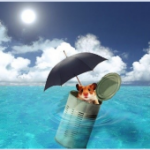 Using the picture provided, share a story about what is happening in this picture with someone in your home. Use the following questions to add supporting details to your story: What/Who do you see? What happened before this picture was taken? What do you think will happen next? Extension: On a piece of paper, label and/or write a sentence to represent your story.
Using the picture provided, share a story about what is happening in this picture with someone in your home. Use the following questions to add supporting details to your story: What/Who do you see? What happened before this picture was taken? What do you think will happen next? Extension: On a piece of paper, label and/or write a sentence to represent your story.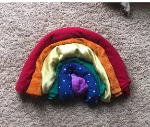 Try and create a picture using your laundry! Find between 5-10 items of laundry (e.g., different coloured socks, t-shirts, pants, pajamas etc.). What can you make using the laundry you found?
Try and create a picture using your laundry! Find between 5-10 items of laundry (e.g., different coloured socks, t-shirts, pants, pajamas etc.). What can you make using the laundry you found?